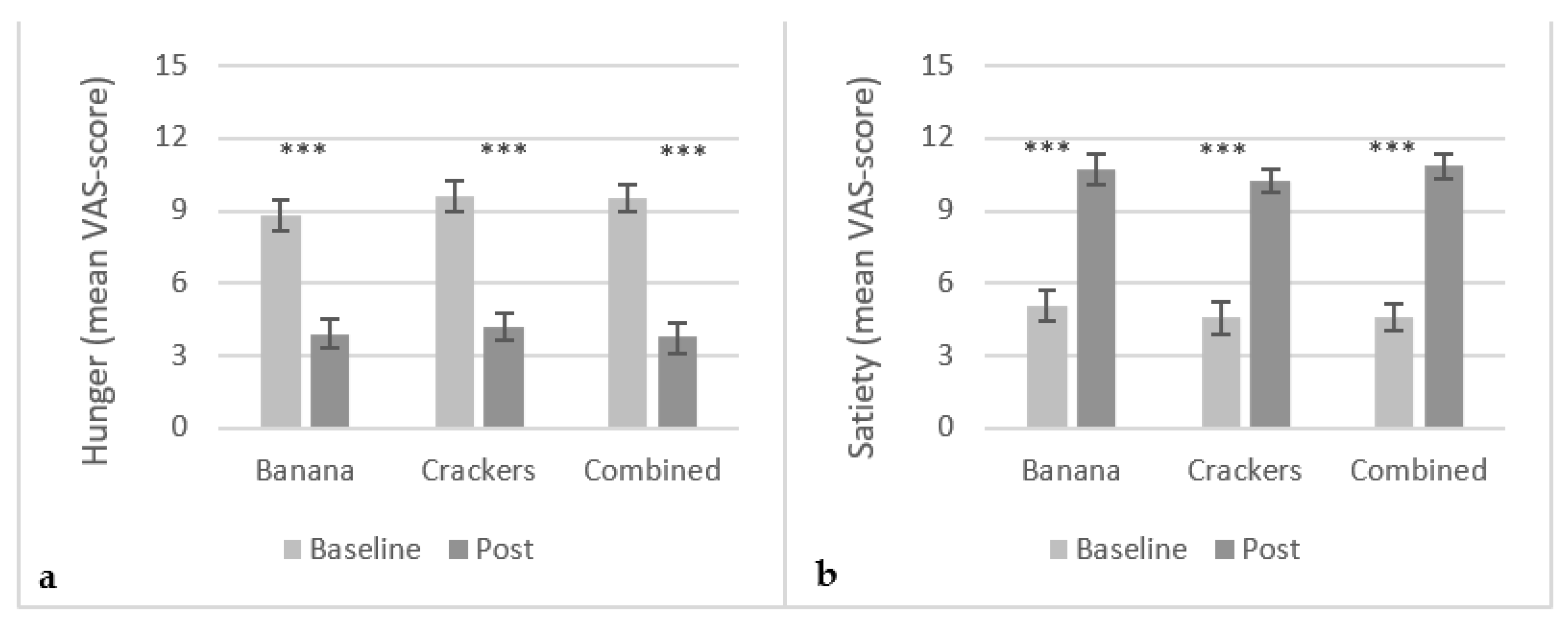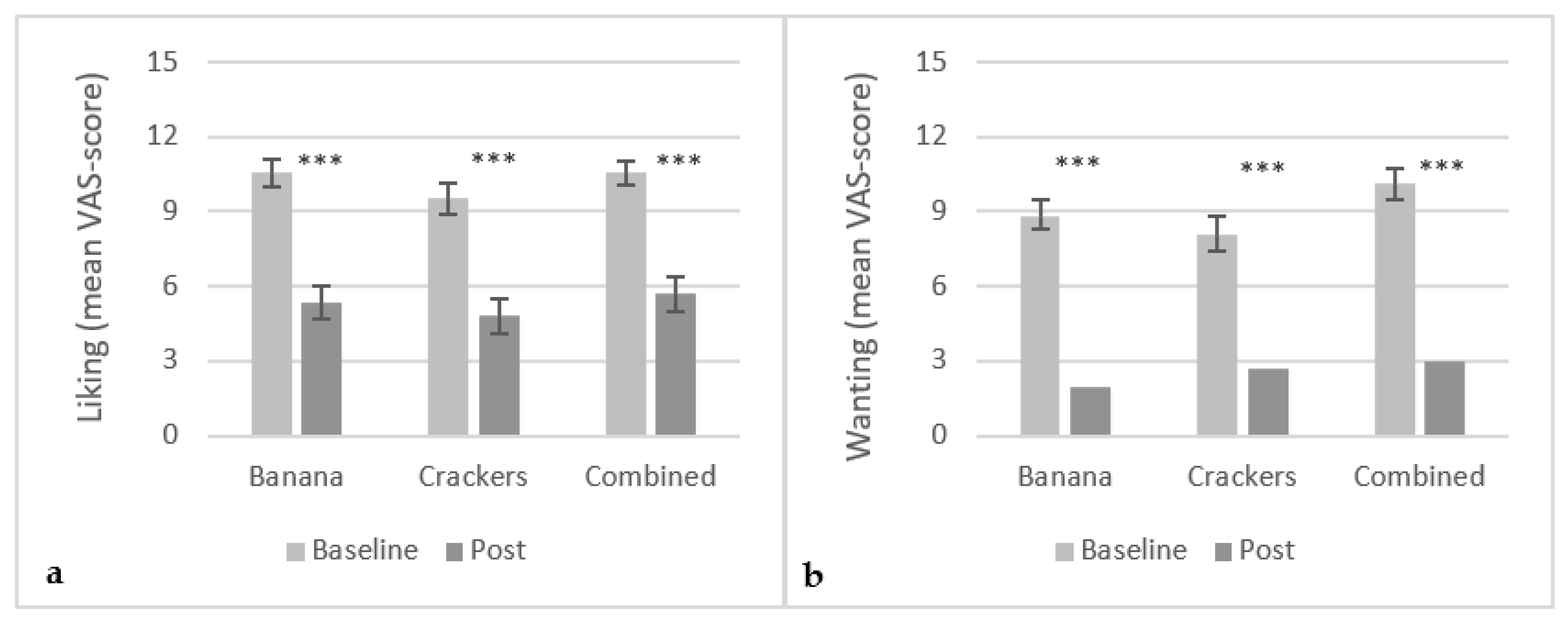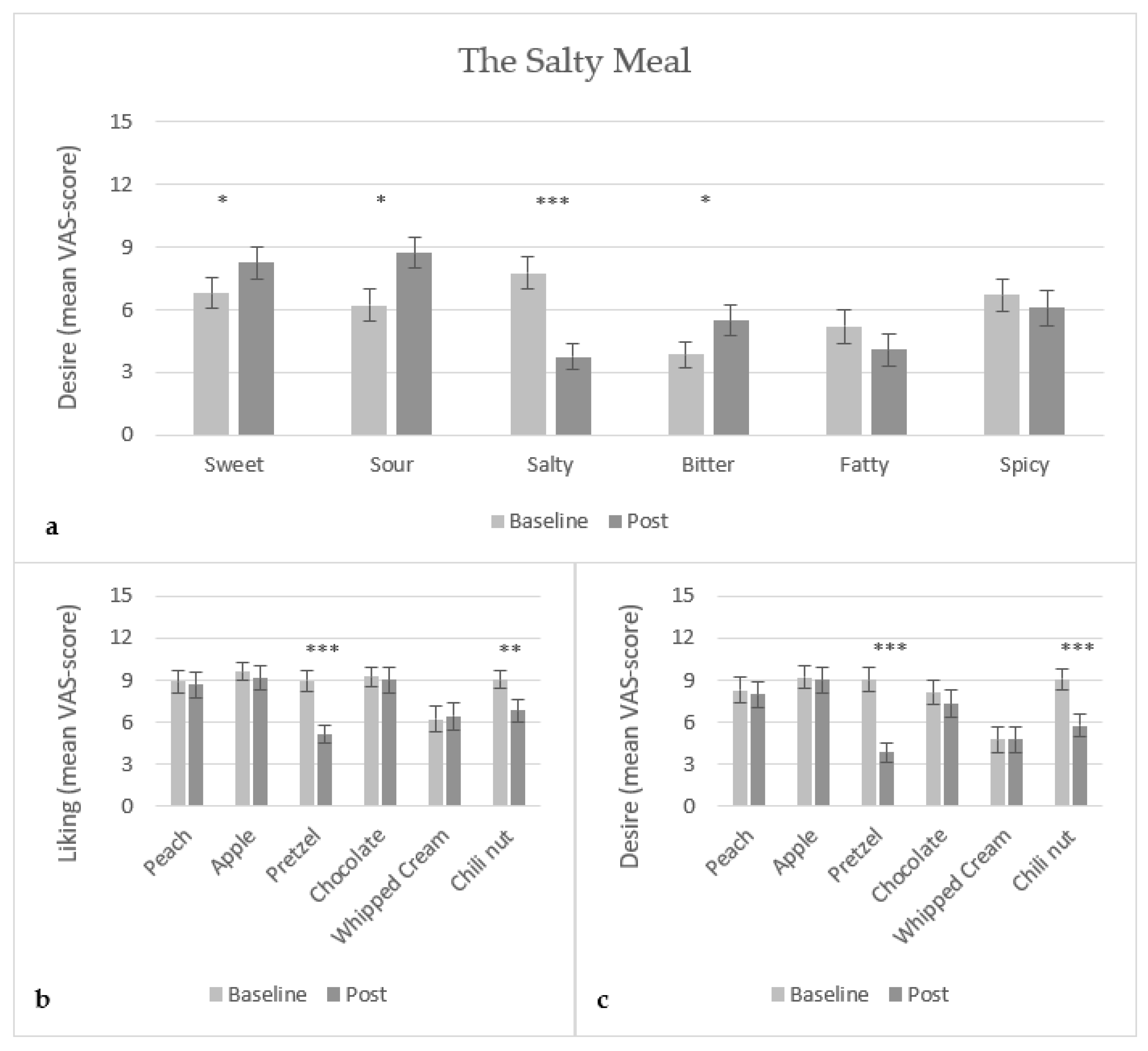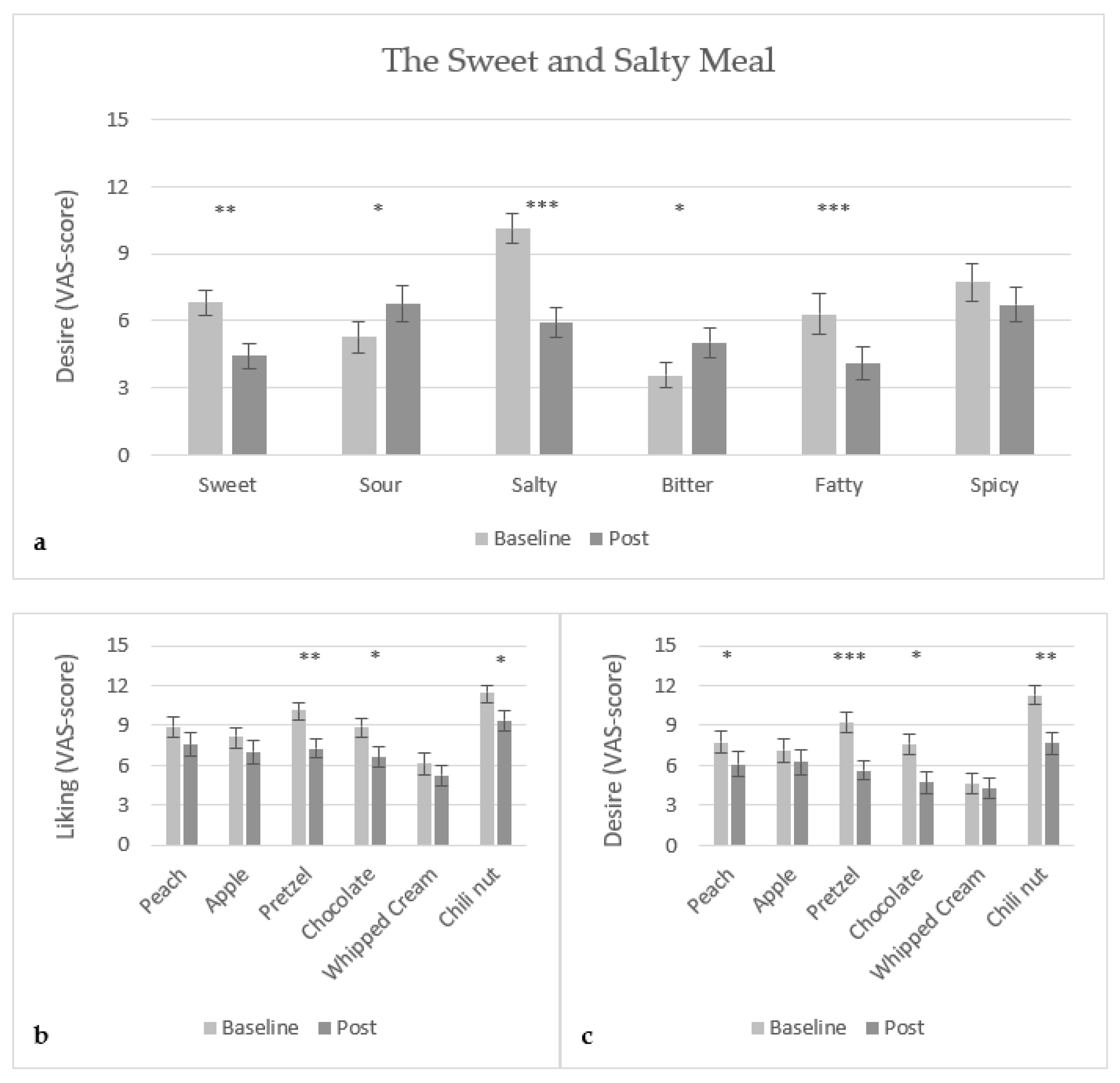Sensory Specific Desires. The Role of Sensory Taste Exposure in Desire for Food with a Similar or Different Taste Profile
Abstract
:1. Introduction
2. Materials and Methods
2.1. Participants and Recruitment
2.2. Test Stimulus
2.2.1. Sweet Meal Exposure
2.2.2. Salty Meal Exposure
2.2.3. Sweet + Salty Meal Exposure
2.3. Food Samples with Specific Sensory Profile
2.4. Procedure
- (1)
- Introduction: Upon arrival, participants were introduced to the experiment by receiving an overview of the experiment steps along with the questionnaires. Further, participants were instructed in how to use a VAS scale. The purpose of the experiment was not explained.
- (2)
- Serving and rating of food samples with a pronounced sensory profile: Each participant was served six food samples (peach, pretzel, green apple, dark chocolate, whipped cream and chilli nuts, Table 2), and instructed to taste the food samples in the order presented in questionnaire. The order was randomized between participants, however, the food samples were presented in the same order for each participants both before and after the meal exposure (sweet, salty or sweet + salty). Immediately after eating a food sample, participants were instructed to rate their liking of the food sample (“How much do you like the sample right now?”) and their wanting for more (“If you were offered another portion, how much would you then want to eat it?”). One cup of water was provided for palate cleansing before proceeding to the next step.
- (3)
- Rating of appetite sensations: At baseline, participants were instructed to rate their overall feeling of hunger (“How hungry are you right now?”), satiation (“How satiated are you right now?”), general liking of the food presented in main meal (banana, crackers or both) (“How much do generally like banana/crackers?”), and their desire for the main meal (“How much do you want to eat banana/crackers right now?”).
- (4)
- Serving and rating of the meal with a pronounced sensory profile: Depending on the exposure, participants were served either banana (sweet meal), salty crackers (salty meal) or banana + salty crackers combined (sweet + salty meal). Beginning at the same time, participants were served one serving of the meal, and were instructed to eat the whole serving before making their rating. Afterwards, participants were instructed to evaluate liking (“How much do you like the banana/crackers right now?”), sensory profile perception (“What is the dominating taste?” (Sour, sweet, salty, bitter, fatty, spicy)), hunger, satiation and desire for more of the meal. Further, participants were asked to rate their desire for eating something sweet, salty, sour, bitter, fatty, and spicy (“How much do you want to eat something sweet/salty/sour/bitter/fatty/spicy?”). This step was repeated until the participant was comfortably satiated (limit was set at maximum 10 servings of banana or salty crackers, and 15 servings of banana + salty crackers). This allowed the study of dynamics in palatability, appetite and desires as they developed over the meal. When reaching the state of comfortably satiated, participants were not served further servings of meal, and proceeded to next step.
- (5)
- Evaluation of subjective sensory desires: Upon reaching the state of “comfortable satiation”, participants were served the food samples once again in the same order as in step 2, and where were instructed to evaluate liking and wanting for food samples.
- (6)
- Demographics: At the end of the test day, participants filled out a final questionnaire regarding; weight, height, age, gender, and educational level. They were thanked for their participation and assured anonymity. To minimize disturbance, participants were asked to stay in the room until all participants had completed the experiment.
2.5. Statistical Analyses
3. Results
3.1. Sensory Perception of the Exposure Meal
3.2. Effect on Appetite, Liking and Desire Ratings
3.3. Effect on Sensory Specific Desires
3.3.1. Effect of the Sweet Exposure Meal
3.3.2. Effect of the Salty Exposure Meal
3.3.3. Effect of the Combined Sweet and Salty Exposure Meal
3.4. Comparison of Sensory Desires between the Exposure Meals
4. Discussion
4.1. Effect on Sensory Specific Desires
4.2. Comparison of SSD between Simple Food vs. Complex Food
4.3. Limitations
5. Conclusions
Author Contributions
Funding
Institutional Review Board Statement
Informed Consent Statement
Data Availability Statement
Acknowledgments
Conflicts of Interest
References
- Lacaille, L. Eating Behavior. In Encyclopedia of Behavioral Medicine; Springer Science and Business Media: New York, NY, USA, 2013. [Google Scholar] [CrossRef]
- Laviano, A.; Di Lazzaro, L.; Koverech, A. Changes in eating behavior, taste and food preferences and the effects of gastrointestinal hormones. Clin. Nutr. Exp. 2018, 20, 65–70. [Google Scholar] [CrossRef]
- Köster, E. Diversity in the determinants of food choice: A psychological perspective. Food Qual. Prefer. 2009, 20, 70–82. [Google Scholar] [CrossRef]
- Sørensen, L.B.; Møller, P.; Flint, A.; Martens, M.; Raben, A. Effect of sensory perception of foods on appetite and food intake: A review of studies on humans. Int. J. Obes. 2003, 27, 1152–1166. [Google Scholar] [CrossRef] [Green Version]
- Forde, C.G. From perception to ingestion; the role of sensory properties in energy selection, eating behaviour and food intake. Food Qual. Prefer. 2018, 66, 171–177. [Google Scholar] [CrossRef]
- McCrickerd, K.; Forde, C. Sensory influences on food intake control: Moving beyond palatability. Obes. Rev. 2016, 17, 18–29. [Google Scholar] [CrossRef] [Green Version]
- Engelen, L.; de Wijk, R.A.; Prinz, J.F.; van der Bilt, A.; Bosman, F. The relation between saliva flow after different stimulations and the perception of flavor and texture attributes in custard dessert. Physiol. Behav. 2003, 78, 165–169. [Google Scholar] [CrossRef]
- Ferriday, D.; Brunstrom, J.M. ‘I just can’t help myself’: Effects of food-cue exposure in overweight and lean individuals. Int. J. Obes. 2011, 35, 142–149. [Google Scholar] [CrossRef] [PubMed] [Green Version]
- Zoon, H.F.A.; De Graaf, C.; Boesveldt, S. Food Odours Direct Specific Appetite. Foods 2016, 5, 12. [Google Scholar] [CrossRef]
- Ramaekers, M.G.; Boesveldt, S.; Lakemond, C.M.M.; Boekel, M.A.J.S.V.; Luning, P.A. Odors: Appetizing or satiating? Development of appetite during odor exposure over time. Int. J. Obes. 2014, 38, 650–656. [Google Scholar] [CrossRef] [PubMed]
- Proserpio, C.; de Graaf, C.; Laureati, M.; Pagliarini, E.; Boesveldt, S. Impact of ambient odors on food intake, saliva production and appetite ratings. Physiol. Behav. 2017, 174, 35–41. [Google Scholar] [CrossRef]
- Rolls, B.J.; Rolls, E.; Rowe, E.A.; Sweeney, K. Sensory specific satiety in man. Physiol. Behav. 1981, 27, 137–142. [Google Scholar] [CrossRef]
- Rolls, B.J.; Rowe, E.A.; Rolls, E.T. How sensory properties of foods affect human feeding-behaviour. Physiol. Behav. 1982, 29, 409–417. [Google Scholar] [CrossRef]
- Rolls, B.J.; Van Duijvenvoorde, P.; Rolls, E. Pleasantness changes and food intake in a varied four-course meal. Appetite 1984, 5, 337–348. [Google Scholar] [CrossRef]
- Guinard, J.X.; Brun, P. Sensory Specific Satiety. Comparison of taste and texture efefcts. Appetite 1998, 31, 141–157. [Google Scholar] [CrossRef]
- Andersen, B.; Byrne, D.; Bredie, W.; Møller, P. Cayenne pepper in a meal: Effect of oral heat on feelings of appetite, sensory specific desires and well-being. Food Qual. Prefer. 2017, 60, 1–8. [Google Scholar] [CrossRef]
- Olsen, A.; Ritz, C.; Hartvig, D.L.; Møller, P. Comparison of sensory specific satiety and sensory specific desires to eat in children and adults. Appetite 2011, 57, 6–13. [Google Scholar] [CrossRef]
- Duerlund, M.; Andersen, B.V.; Byrne, D.V. Sensory Specific Desires Affect and are Affected by Actual Snack Choice. J. Food Nutr. Health 2021, 2, 107. [Google Scholar] [CrossRef]
- Meule, A. The Psychology of Food Cravings: The Role of Food Deprivation. Curr. Nutr. Rep. 2020, 9, 251–257. [Google Scholar] [CrossRef] [PubMed]
- Griffioen-Roose, S.; Finlayson, G.; Mars, M.; Blundell, J.E.; de Graaf, C. Measuring food reward and the transfer effect of sensory specific satiety. Appetite 2010, 55, 648–655. [Google Scholar] [CrossRef]
- Rogers, P.J.; Ferriday, D.; Irani, B.; Hoi, J.K.H.; England, C.Y.; Bajwa, K.K.; Gough, T. Sweet satiation: Acute effects of consumption of sweet drinks on appetite for and intake of sweet and non-sweet foods. Appetite 2020, 149, 104631. [Google Scholar] [CrossRef] [PubMed]
- Mela, D.J. Eating for pleasure or just wanting to eat? Reconsidering sensory hedonic responses as a driver of obesity. Appetite 2006, 47, 10–17. [Google Scholar] [CrossRef]
- Rolls, B.J.; Hetherington, M. The role of variety in eating and body weight regulation. In Handbook of the Psychophysiology of Human Eating; Shepard, R., Ed.; John Wiley & Sons Ltd.: Hoboken, NJ, USA, 1989; pp. 75–84. [Google Scholar]
- Duerlund, M.; Andersen, B.V.; Grønbeck, M.S.; Byrne, D.V. Consumer reflections on post-ingestive sensations. A qualitative approach by means of focus group interviews. Appetite 2019, 142, 104350. [Google Scholar] [CrossRef]
- Duerlund, M.; Andersen, B.V.; Byrne, D.V. Dynamic changes in Post-Ingestive Sensations after Consumption of a Breakfast Meal Hign in Protein or Carbohydrate. Foods 2019, 8, 413. [Google Scholar] [CrossRef] [PubMed] [Green Version]
- Odermatt, A. The Western-style diet: A major risk factor for impaired kidney function and chronic kidney disease. Am. J. Physiol. Physiol. 2011, 301, F919–F931. [Google Scholar] [CrossRef] [PubMed] [Green Version]
- Cornil, Y.; Chandon, P. Pleasure as an ally of healthy eating? Contrasting visceral and Epicurean eating pleasure and their association with portion size preferences and wellbeing. Appetite 2016, 104, 52–59. [Google Scholar] [CrossRef] [PubMed]
- Møller, P. Satisfaction, satiation and food behaviour. Curr. Opin. Food Sci. 2015, 3, 59–64. [Google Scholar] [CrossRef]





| Characteristics | Sweet Meal Exposure | Salty Meal Exposure | Sweet + Salty Meal Exposure |
|---|---|---|---|
| Total number of participants (N) | 29 | 28 | 28 |
| Gender (Number of females/number of males) | 23/6 | 23/5 | 25/3 |
| Age (years) a | 28.5 (±19.8) | 29.2 (±9.9) | 31.2 (±12.1) |
| BMI (kg/m2) a | 23.3 (±4.7) | 24.1 (±5.3) | 22.6 (±4.6) |
| Educational level b | 4.4 (n2 = 6, n4 = 2, n5 = 13, n6 = 7, n7 = 1) | 4.8 (n2 = 5, n4 = 1, n5 = 13, n6 = 9) | 4.8 (n1 = 1, n2 = 2, n4 = 2, n5 = 12, n6 = 9, n7 = 1) |
| Overall liking of banana (cm) c | 10.1 (±2.4) | -- | 9.6 (±3.2) |
| Overall liking of crackers (cm) c | -- | 9.0 (±3.4) | 10.6 (±3.3) |
| Sweet | Sour | Salt | Bitter | Spicy | Fat |
|---|---|---|---|---|---|
| Canned peach | Green apple with two drops of lemon juice | Pretzel | Dark chocolate | Chilli nut | Whipped cream |
| Sweet Meal | Salty Meal | Sweet + Salty Meal | |
|---|---|---|---|
| Desire for: | |||
| Sweet | 4.42 (±3.90) A | 8.23 (±4.02) B | 4.42 (±3.00) AC |
| Salty | 9.64 (±3.24) A | 3.72 (±3.24) B | 5.91 (±3.60) BC |
| Sour | 5.32 (±4.05) A | 8.72 (±3.88) B | 6.76 (±4.28) AB |
| Bitter | 4.86 (±4.63) A | 5.49 (±3.92) A | 5.04 (±3.52) A |
| Fatty | 2.97 (±3.8) A | 4.07 (±3.97) A | 4.10 (±3.97) A |
| Spicy | 7.48 (±4.41) A | 6.07 (±4.32) A | 6.71 (±4.14) A |
| Liking of: | |||
| Peach | 7.02 (±4.27) A | 8.70 (±4.80) A | 7.57 (±4.41) A |
| Pretzel | 10.44 (±4.80) A | 5.41 (±3.42) B | 7.30 (±3.84) BC |
| Apple, green | 8.02 (±4.44) A | 9.11 (±4.52) A | 7.01 (±4.75) A |
| Chocolate, dark | 9.60 (±4.00) A | 9.03 (±4.83) AB | 6.60 (±4.03) BC |
| Whipped cream | 5.54 (±4.50) A | 6.41 (±4.93) A | 5.21 (±4.30) A |
| Chilli nut | 9.70 (±3.81) A | 6.81 (±4.52) A | 9.40 (±4.03) A |
| Desire for: | |||
| Peach | 5.34 (±5.53) A | 8.00 (±4.90) A | 6.10 (±4.90) A |
| Pretzel | 10.00 (±4.50) A | 3.83 (±3.85) B | 5.61 (±3.90) BC |
| Apple, green | 7.04 (±4.80) A | 9.03 (±4.91) A | 6.30 (±5.05) A |
| Chocolate, dark | 7.49 (±4.61) A | 7.32 (±5.24) A | 4.71 (±4.41) A |
| Whipped cream | 3.21 (±3.71) A | 4.75 (±5.00) A | 4.30 (±4.12) A |
| Chilli nut | 8.31 (±5.00) A | 5.80 (±4.52) A | 7.70 (±4.3) A |
Publisher’s Note: MDPI stays neutral with regard to jurisdictional claims in published maps and institutional affiliations. |
© 2021 by the authors. Licensee MDPI, Basel, Switzerland. This article is an open access article distributed under the terms and conditions of the Creative Commons Attribution (CC BY) license (https://creativecommons.org/licenses/by/4.0/).
Share and Cite
Chaaban, N.; Andersen, B.V. Sensory Specific Desires. The Role of Sensory Taste Exposure in Desire for Food with a Similar or Different Taste Profile. Foods 2021, 10, 3005. https://doi.org/10.3390/foods10123005
Chaaban N, Andersen BV. Sensory Specific Desires. The Role of Sensory Taste Exposure in Desire for Food with a Similar or Different Taste Profile. Foods. 2021; 10(12):3005. https://doi.org/10.3390/foods10123005
Chicago/Turabian StyleChaaban, Nora, and Barbara Vad Andersen. 2021. "Sensory Specific Desires. The Role of Sensory Taste Exposure in Desire for Food with a Similar or Different Taste Profile" Foods 10, no. 12: 3005. https://doi.org/10.3390/foods10123005
APA StyleChaaban, N., & Andersen, B. V. (2021). Sensory Specific Desires. The Role of Sensory Taste Exposure in Desire for Food with a Similar or Different Taste Profile. Foods, 10(12), 3005. https://doi.org/10.3390/foods10123005







